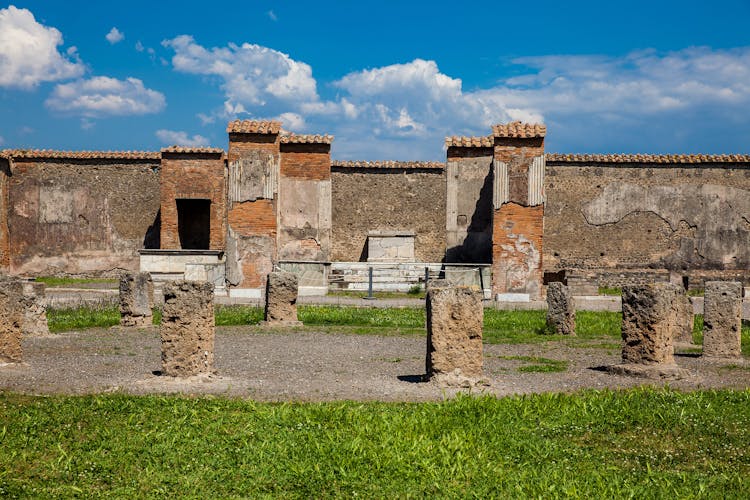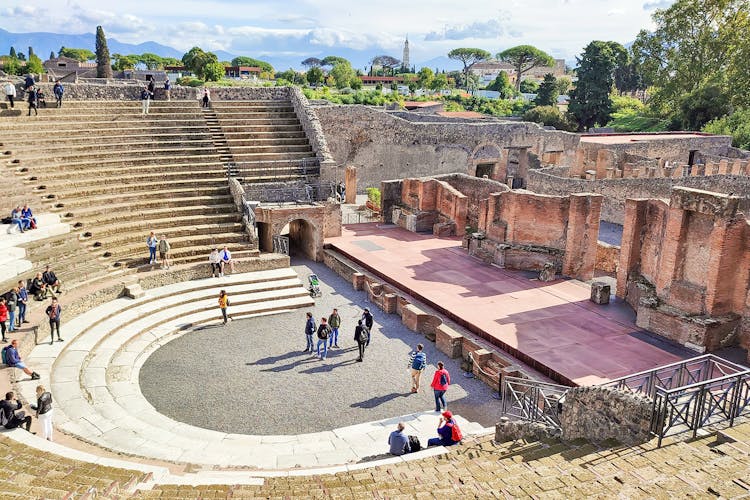Covering an area of 170 acres, Pompeii is a vast archaeological site that requires more than just a quick visit. Divided into nine regions, each with its unique charm, the city offers a glimpse into over 2000 years of history. With so much to see, you might wonder where to start from and what to expect. But fear not! This blog will be your guide, helping you navigate the ancient streets of Pompeii and ensuring you don't miss out on its most fascinating sights.
Understanding the Pompeii sites

Pompeii is divided into nine regions, with Regions VI, VII, and VIII offering some of the most interesting sights. Be prepared for a lot of walking as you explore the vast ruins. In the heart of Pompeii is a massive Forum and the impressive Grand Theater. There’s another huge Amphitheater in Region II and this is where the alternative entrance to Pompeii is. The site is also home to numerous large buildings and structures, such as the Basilica, which served as a court of law. The Archaeological Park houses a wealth of artifacts and exhibits, providing a fascinating glimpse into the daily lives of Pompeii's inhabitants. To make the most of your visit, prioritize the areas that interest you most and plan your route accordingly. Hiring a guide is 100% worth it because they can provide valuable insights and help you navigate the complex site efficiently.
Recommended tickets to Pompeii
When purchasing tickets to Pompeii, a guided tour or audio guide is a must. Skip-the-line tickets are also recommended, especially during peak season from June to September, to avoid long queues. If you plan to visit both Pompeii and nearby Herculaneum, look for combination tickets that offer access to both sites at a discounted rate.
Must-see at Pompeii
1The Pompeii Forum
The Pompeii Forum was the vibrant heart of the city, where politics, social life, and commerce thrived. Flanked by iconic landmarks like the Temple of Jupiter and the Basilica, this bustling hub underwent significant transformations between the 3rd and 2nd centuries BC. As you stroll through this ancient square, you can imagine the hustle and bustle of daily life in Pompeii, where citizens gathered to discuss politics, conduct business, and socialize.

2Antiquarium
The Antiquarium, built between 1873 and 1874, houses a fascinating collection of artifacts from Pompeii. Here, you can explore the daily life of the ancient city through these exhibits, which include plaster casts of victims preserved by the volcanic ash from the eruption of Mount Vesuvius. The museum, refurbished and reopened in 2021, traces Pompeii's history from the 4th century BC to the tragic eruption in AD 79, showcasing the city's most significant finds.

3Temple of Apollo
The Temple of Apollo, one of Pompeii's oldest and most important religious sites, dates back to the 2nd century BC. The temple features a stunning peristyle with 48 Ionic columns and a central cella housing a statue of Apollo.

4Villa dei Misteri
The Villa dei Misteri, located outside the city walls, is renowned for its well-preserved frescoes depicting the initiation rites of a young woman into the cult of Dionysus. These vibrant, life-sized frescoes offer a rare glimpse into the mysterious religious practices of ancient Pompeii. The villa also features elegant living quarters and beautiful gardens, providing visitors with a sense of the opulent lifestyle enjoyed by the city's wealthy residents before the catastrophic eruption.

5House of Vetti
The House of the Vettii, one of Pompeii's most opulent residences, was owned by wealthy freedmen brothers Aulus Vettius Conviva and Aulus Vettius Restitutus. Restructured in the Augustan era, the house features a large garden with statues and water jets as its focal point. Richly decorated rooms surround the peristylium, including a living room with a frieze depicting Cupids engaged in various activities. The entrance boasts a striking fresco of Priapus, symbolizing the brothers' prosperity, while a graffiti reveals that a prostitute named Eutychus conducted her affairs in an adjacent room adorned with erotic paintings.

6Stabian Baths
The Stabian Baths, the oldest and largest thermal complex in Pompeii, date back to the 2nd century BC. The baths feature separate sections for men and women, each with a frigidarium (cold room), tepidarium (warm room), and caldarium (hot room). The complex also includes a large exercise yard (palaestra) and a swimming pool.

7The Casts
One of the most poignant and haunting aspects of Pompeii is the plaster casts of the victims, preserved in their final moments by the volcanic ash. These casts, created by filling the voids left by decomposed bodies with plaster, offer a chilling glimpse into the human tragedy that unfolded during the eruption.

8House of the Faun
The House of the Faun, one of the largest and most impressive residences in Pompeii, spans an entire city block. Named after the bronze statue of a dancing faun in its atrium, the house features stunning mosaics, including the famous "Alexander Mosaic" depicting the Battle of Issus between Alexander and Darius III of Persia.

9Venus Genetrix
The Venus Genetrix is a stunning marble statue found in the Temple of Venus at Pompeii. This depiction of the goddess Venus, the mythical ancestor of the Roman people, showcases the exceptional artistic skill of the ancient Romans.

10Macellum
The Macellum, Pompeii's central market, features a tuff quadriporticus with a worship hall on the eastern side. Niches in the side wall hold copies of marble statues, likely depicting emperors Titus or Vespasian, indicating the area's use for imperial cult. Adjacent rooms served as meeting spaces and fish markets. A circular tholos in the courtyard was used for selling and cleaning fish, while shops lined the southern side. The portico walls showcased scenes of daily life and mythological subjects, offering a glimpse into the bustling commerce and religious practices of ancient Pompeii.

11Basilica
The Basilica, spanning 1,500 square meters, was the Forum's most opulent building, serving as a space for business and justice administration. Accessed through five tuff pillar-separated entrances, the interior features three naves divided by brick columns with Ionic capitals. A richly decorated suggestum for judges sits at the western end. The walls boast luxurious stucco resembling marble blocks.

12Amphitheatre
The Amphitheatre in Pompeii, built around 70 BC, is one of the oldest surviving Roman amphitheaters. Capable of seating up to 20,000 spectators, it hosted thrilling gladiatorial contests and public spectacles that drew crowds from neighboring towns. The elliptical structure features tiered seating accessible via external staircases and corridors. A parapet adorned with frescoes of gladiators separates the arena from the spectator area. The Amphitheatre's design, with its complex underground passages and chambers for staging elaborate events, served as a model for later Roman amphitheaters.


